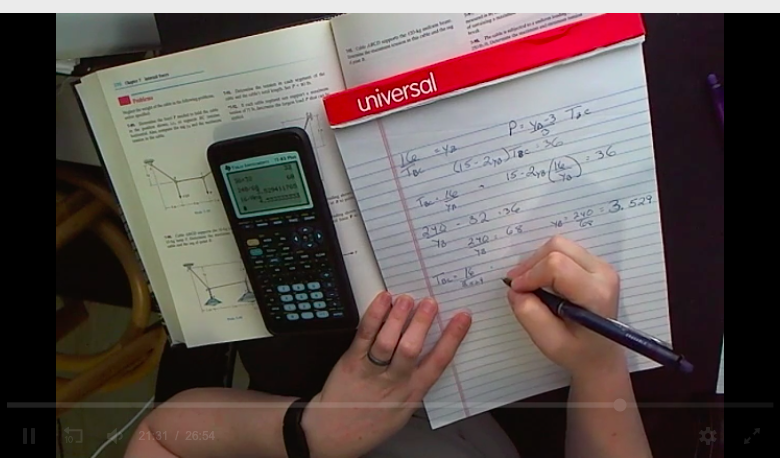On Learning Goals and Trust in the Time of Coronavirus…
... or, how I learned to stop worrying and love the remote instruction (but not really)

I started this article on remote teaching a few weeks ago when just about every college and university was scrambling to covert their in-person classes to a remote instruction model. But then, well, I got busy trying to covert my in-person classes to a remote instruction model. So, instead of a list of resources, I’m going to focus on the most important aspects of teaching remotely during this pandemic.
I’ve taught online before. This is very different. As we do online learning (when it’s planned that way), it is often done completely asynchronously and with specific care taken to designing the course to be delivered online right from the get go. At my college, we even get an instructional designer to help plan and implement our course. To be honest, my first trial at it was not very good. I assigned too much, both for the students and for myself to grade. I didn’t do enough to encourage all class discussions asynchronously. I missed that face to face. And, most of all, I very unintelligently took on two sections at once. At least I’ll never make that mistake again.
Rather, we’re all in the rush to convert an in-person syllabus to an online format in a very short period of time. Some folks only got a day or two’s notice. I had a whole week and yet with the effects of this situation on my anxiety disorder, I didn’t make very good use of it. In addition, we’ve been asked to make contingency plans to cover each others’ courses in case one of us is “unavailable.” (You know, nice way of saying clinging to life support or some shit like that.) So I don’t have the time to be as intentional as I’d like to be.
The first and most important part of this process is to re-assess your learning goals for the semester. You should have a list of several benchmarks that you need your students to reach which you determine through assessments (tests, quizzes, projects, papers, etc.) Then, pare down to the absolutely most essential learning goals that are left in your semester. Why? Because there’s a GODDAMN GLOBAL PANDEMIC happening and a lot of us are experiencing trauma as a result. Expecting your students to carry on as normal is unrealistic.
If you’ve been following this topic, you’ve probably read the article imploring you to do a bad job of putting your college courses online. The author points out many reasons why your students may not be able to treat this as business as usual, such as limited internet access, childcare responsibilities, and even abusive home situations. But, even if your students have the best possible scenario, we’re experiencing a collective trauma that will change the world as we know it. In a way, I think of my college students as being in the position I was in on 9/11. I was a college freshman… that event changed the world that I was rapidly becoming an adult in. I’ve already shared this in a Quickies post, but assistant professor of political science, Aisha Ahmad, makes a really good case on the Chronicle of Higher Ed for the most important things for our students (and for us) at this time, namely finding security and adapting to this new normal, whatever it is. We can’t fix trauma, but we can work with our students in a way that is sensitive to it.
I don’t know the details of all my students’ stories. At least one is working long overnight shifts stocking grocery stores. Another is just losing track of time… feeling untethered. Several are sharing limited computer resources with family members. One of my colleagues is in a house where there are THREE of them teaching and two still in school. Everyone has a story, and not everyone is willing to share it. So, paring down the essentials is the best way to go. Also, trust your students. Don’t ask for documentation for late work. I’ve seriously seen someone suggest that, but no one is able to give me a doctor’s note for the massive anxiety attack I had in my home office. Why the hell would I expect that of someone else? Don’t set up nanny-cam type proctoring for their exams. Students didn’t sign up for that when they took your course.
Illustrating with examples is usually helpful, so I’ll tell you a little about my two classes and lab. First, I’m teaching Statics, a sophomore/junior level engineering course for our physics majors. Some just need it as an upper level requirement. Others need this as a stepping stone to the next courses in the sequence, namely, Dynamics and Strength of Materials. So I can’t just throw my hands up and say, “well, we’ve done good enough!” At the beginning of the semester, I made up a list of 15 learning goals… 15 skills they had to demonstrate through weekly quizzes consisting of one problem each. So, I’m using the remaining learning goals to drive the rest of the course. Now the quizzes are online, so, yeah, I said go ahead and use the book. Ask each other for help. I was planning on a collaborative final anyway! I might throw in a problem that is slightly longer than one I would give for a 20-minute closed-book quiz. To prepare for each quiz, we were doing practice problems together in class, then they did more for homework. So far I’ve been making some problem solving videos with pen and paper, plus going through problems with them on Zoom using its whiteboard (recorded and optional, of course). Turns out, I’m kind of crap with a stylus. But we’re muddling through. I cut all the remaining homework assignments in half. They send me pictures of their work and I comment on it and return it with my solution set. The students who are going on in this field know they have to get some of this down for their next class in the sequence, so I trust them to do what work they need to. And, I am obnoxiously reminding them of my Zoom office hours. I have my first quiz of online-only work to grade this weekend, so we’ll see how that worked? Hearing that my class was one of the least stressful for some of them, however, is a good sign for me.
My other class is a general education course called “Life Beyond Earth.” It is my FAVORITE course to teach! It fulfills the science requirement for the college, so all (but one) of the students are not science majors. It also has a lab and it ALSO has a writing intensive component. As such, I have two lists of learning goals that are required by the college, one on science and one on writing. Knowing none of my students are going on to be astrobiologists, I honed my work down to those. The term paper is probably the biggest one, with several intermediate deadlines and peer reviews. Luckily, our writing center is still at work, virtually, and out college librarians continue to be AWESOME at finding resources for us, so I htink that’ll be okay. Otherwise, I’m turning their closed-book essay tests into open-book essay tests. I’m scaling back on the difficulty of the questions, and focusing on the scientific learning goals that I don’t think we did enough on so far. (I seriously cannot wait to talk about ethics in human spaceflight!) The exams are based on the worksheets that we review over Zoom (also, optional and recorded) and some of the powerpoints that highlight important points. In addition, there are video lectures and readings that give context, but I won’t be drawing specifically from them for the exam. For this class and for Statics, I’m trying to offer a wide range of content but making it clear which things are necessary for a grade and which are “extra.” I cut out the remainder of the labs, except for two, and I scaled both of those back. I couldn’t NOT give them a citizen science activity, after all.
Now that I’ve typed it out, it looks like a lot. It FEELS like a lot when I’m creating it. But, I keep a short list of all graded assignments and exactly what you need to know for them on the learning management site. The rest… the rest is, I think, me trying to make up for the lack of face-to-face interaction with them every week. Teaching can and will fill every available nook of time that you give it, if you let it, especially if you love it. And teaching from my home office is just not the same as being in a classroom full of students and whiteboards.
I’ve made it clear to my students that I’m trying to manage my own mental health, as well. I’ve often found it beneficial to be open about this with students, as it brings some to open up in a way that they would not have otherwise. One day, I was freaking out so badly I took the max dose of hydroxyzine prescribed by my psychiatrist. However, it’s also an antihistamine, and it made me SLEEPY. But not sleepy like, “I’m going to fall over and take a nap,” but that kind of weird drugginess that makes solving a Statics problem in real time with a stylus you already suck at using… well let’s say that wasn’t my best teaching moment. (Minus sign goes… where?) Next Zoom meeting I told them what had happened. And we just moved on to the next problem.
We’re going through something strange and new together. I don’t know where this is going to take us… no one does. But I can be there, be supportive, and get them through the rest of what we’re required to do. And, if it sucks? Well, our college has put out a generous pass/fail option for all students for this semester. I’d be a much happier educator if grades didn’t matter so much in the real world… but that’s another story.





Hi Noisy, This is almost off topic but maybe not quite. You mention a course in a sequence called Dynamics and Strength of Materials. Now I’m keying on just those words… Do you (or they) use a text book called “(Intermediate) Mechanics of Materials”?
Some years ago (wow, i just looked and its been more than a decade) a guy emailed me. He had found a picture I owned online and wanted to use it in a text book he was writing. I said sure and we emailed some forms back and forth so he could use it legally. The only payment I asked for was a copy of the book.
And then I forgot all about it.
About 18 months later I get a package. A text book. Mechanics of Materials. Paged thru it and found the picture. Wow. How cool! But wait. That’s not actually the picture he wanted to use. And they misspelled my last name. Bummer. But it’s still pretty cool! :)
I check in here at Skepchick every day and just seeing that combo of words in your post brought all this to mind.
jim
Ha, that’s awesome! What was it a picture of?
I don’t have that book home with me, but we used an old (3rd?) edition of Mechanics of Materials by Hibbeler. And I’m using 8th ed of his Engineering Mechanics: Statics right now. One of my colleagues bought up a whole batch of each textbook for super cheap, so the students just borrow them from us every year. Because textbooks are EXPENSIVE!
A bungee jumper. A group of us were at the Alameda County Fair (just over the bay from Rebecca!) and they had a bungee jump set up. Haul you up about 100 or 150 feet and then you jump out. It was cool. Way to short, I mean the “ride” lasts less than a second. But still cool.
When we walked up I took some pictures of the person jumping. Handed my camera to a friend and he took pics of me jumping.
The initial picture he wanted to use was one of me. But for whatever reason, they grabbed the pic before that one and used it.
If you ever do come across the book it’s on page 402…
Nice! That certainly is an appropriate activity for that topic.